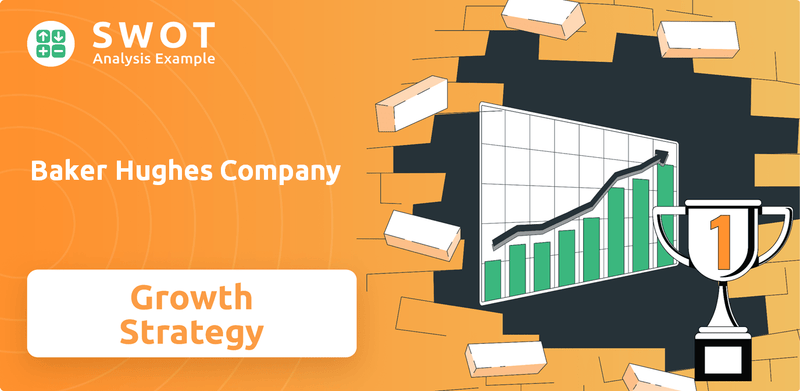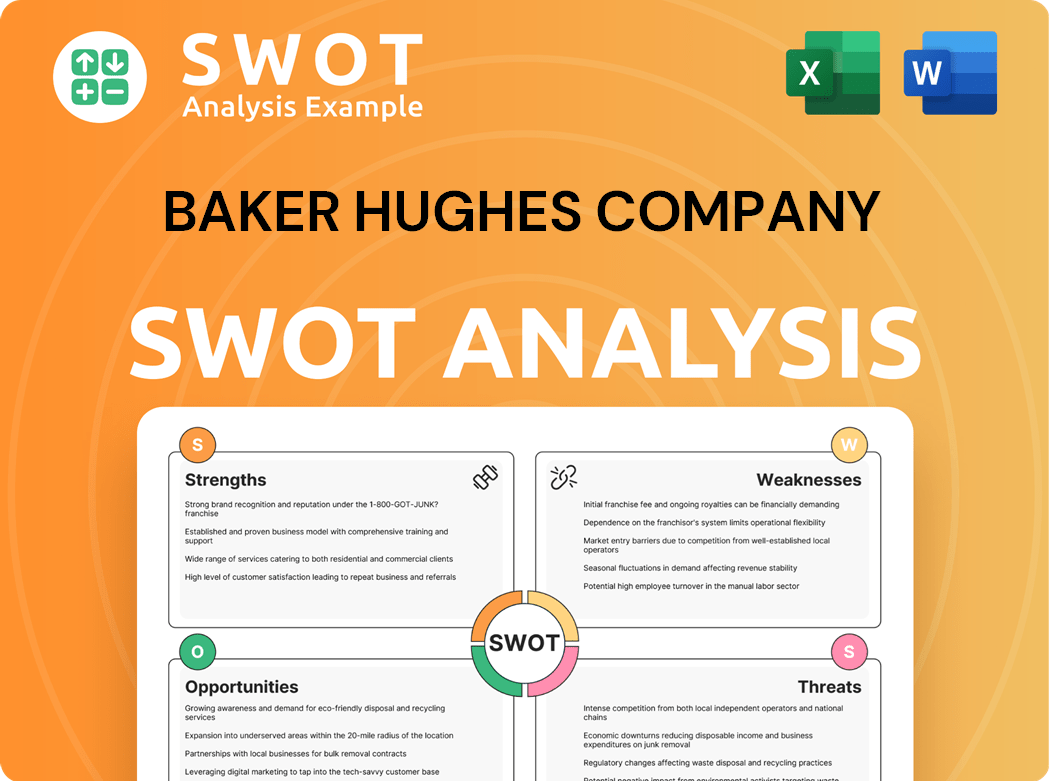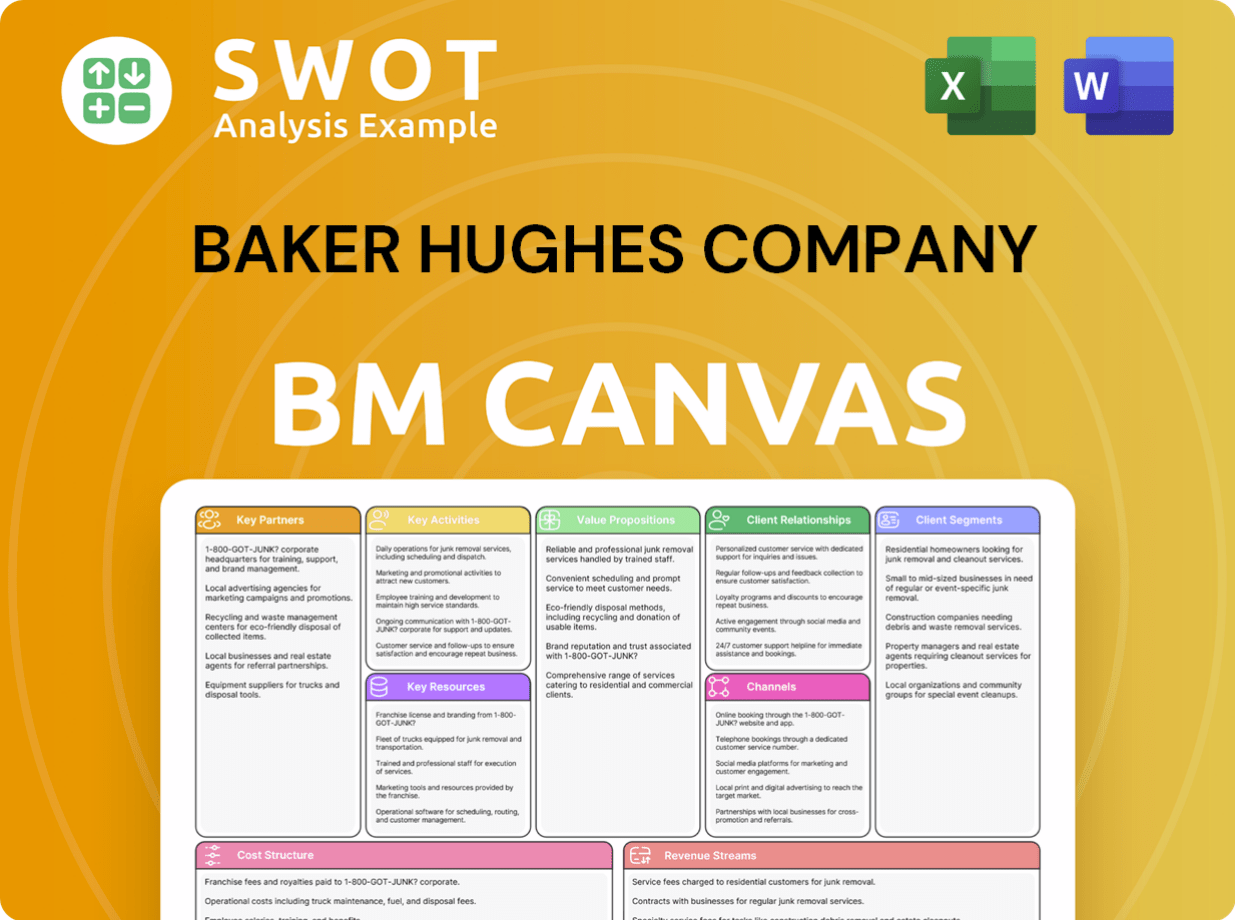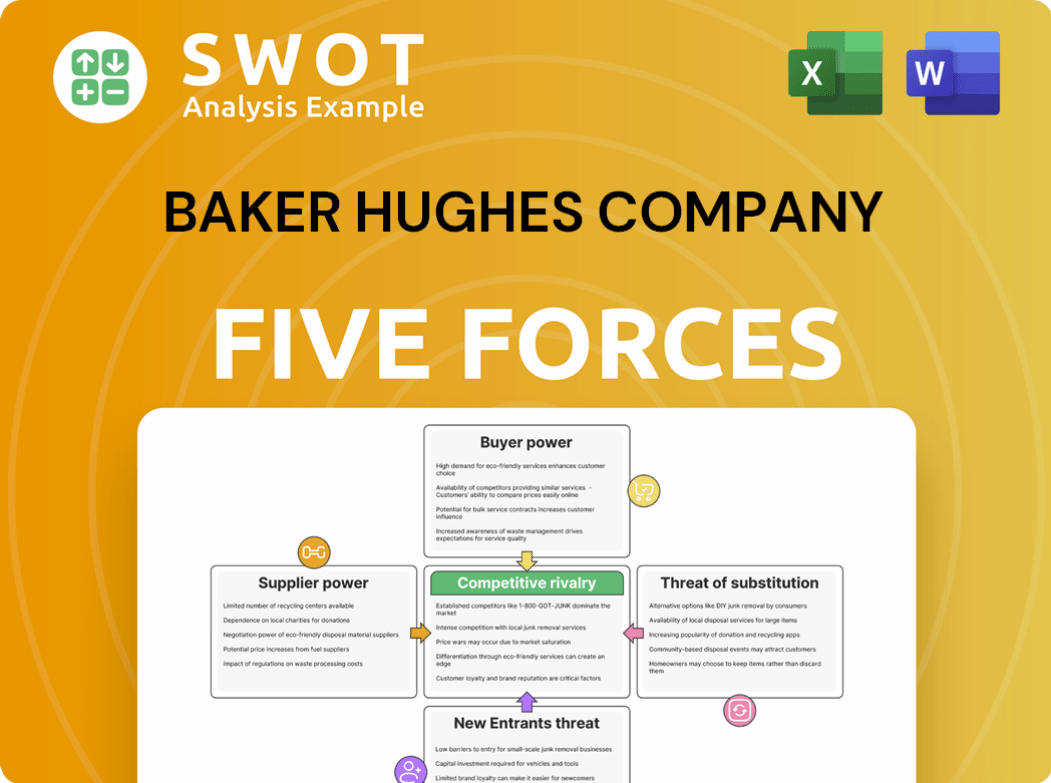Baker Hughes Company Bundle
How is Baker Hughes Shaping the Future of Energy?
Baker Hughes, a titan in the energy technology sector, has consistently redefined its path through strategic maneuvers, most notably its transformative merger with GE Oil & Gas in 2017. This pivotal move propelled Baker Hughes to the forefront, establishing it as a key player in the global energy landscape. Understanding Baker Hughes' Baker Hughes Company SWOT Analysis is crucial to grasping its strategic vision.

This deep dive into Baker Hughes' growth strategy will explore its ambitious plans for expansion, technological innovation, and strategic planning within the ever-changing energy sector. We'll examine the company's future prospects, considering the dynamic oil and gas industry and the broader energy sector outlook. Furthermore, we'll analyze Baker Hughes' financial performance and its position in the competitive landscape, providing insights into potential investment opportunities and sustainable energy initiatives.
How Is Baker Hughes Company Expanding Its Reach?
The expansion initiatives of the company are designed to strengthen its market position and diversify its revenue streams. This involves strategic mergers and acquisitions, along with a focus on emerging energy sectors. The company's approach aims to capture new customer bases and stay ahead of the energy transition, ensuring long-term growth and sustainability.
The company's strategic roadmap includes expanding its digital solutions portfolio, providing advanced analytics and AI-driven insights to optimize customer operations and drive efficiency across the energy value chain. These efforts are supported by partnerships and collaborations to accelerate expansion into new energy value chains. The company's focus on innovation and technology is critical for maintaining a competitive edge in the evolving energy landscape.
The company's growth strategy is multifaceted, emphasizing both organic expansion and strategic acquisitions. The company is actively pursuing opportunities in the liquefied natural gas (LNG) and carbon capture, utilization, and storage (CCUS) markets. For a deeper understanding of the company's structure, consider exploring the Owners & Shareholders of Baker Hughes Company.
The acquisition of Quest Integrity in March 2024 enhanced asset integrity management capabilities. This acquisition is particularly significant in the midstream and downstream sectors. Such strategic moves are designed to integrate advanced inspection and engineering services.
Significant orders in Q1 2024 for LNG technology, including the North Field South (NFS) project in Qatar, highlight commitment. This demonstrates the company's support for global LNG infrastructure development. These initiatives are crucial for growth in the energy sector.
Investments in modular and compact LNG solutions are ongoing, as evidenced by recent collaborations. The company is focused on meeting evolving industry demands. This expansion includes partnerships to accelerate growth in new energy value chains.
Expansion of the digital solutions portfolio is a key part of the strategy. The company provides advanced analytics and AI-driven insights. This optimizes customer operations and drives efficiency across the energy value chain.
The company's expansion strategy involves multiple key initiatives. These initiatives are designed to capitalize on emerging opportunities in the energy sector. The strategic focus is on both immediate gains and long-term sustainability.
- Strategic Mergers and Acquisitions: Enhancing capabilities through acquisitions like Quest Integrity.
- LNG and CCUS Market Focus: Securing significant orders and supporting infrastructure development.
- Product and Service Diversification: Expanding offerings to meet evolving industry demands.
- Digital Transformation: Leveraging advanced analytics and AI to optimize customer operations.
Baker Hughes Company SWOT Analysis
- Complete SWOT Breakdown
- Fully Customizable
- Editable in Excel & Word
- Professional Formatting
- Investor-Ready Format

How Does Baker Hughes Company Invest in Innovation?
The innovation and technology strategy of the company is central to its growth, focusing heavily on research and development (R&D) investments. The company is committed to internal development while also collaborating with external innovators and startups. This approach aims to accelerate technological advancements, especially in areas like digital transformation and sustainable energy solutions.
A key element of this strategy involves digital transformation, utilizing artificial intelligence (AI), the Internet of Things (IoT), and advanced analytics. These technologies are used to optimize operations, improve decision-making, and create new service offerings. The company's iCenter platform, for example, exemplifies this commitment to digital technologies for improved asset performance and efficiency.
The company is also at the forefront of developing and deploying cutting-edge technologies for the energy transition. This includes significant investments in solutions for carbon capture, utilization, and storage (CCUS), hydrogen production and transportation, and geothermal energy. These initiatives are crucial for addressing the evolving needs of the oil and gas industry and the broader energy sector.
The company leverages AI, IoT, and advanced analytics to optimize operations and enhance decision-making. The iCenter platform is a key example of digital solutions for improved asset performance. This digital focus is a core component of their Marketing Strategy of Baker Hughes Company.
Significant investments are made in CCUS, hydrogen production, and geothermal energy solutions. In 2024, the company continued to advance its CCUS portfolio, securing contracts for its modular carbon capture technology. These investments align with the company's broader sustainable energy initiatives.
The company is actively involved in developing and deploying CCUS technologies. They are collaborating with Worley and Aramco on the deployment of their Compact Carbon Capture (CCC) technology. This technology helps reduce emissions from industrial processes.
The company prioritizes R&D investments to drive innovation and technological advancements. This includes both in-house development and collaborations with external innovators. This focus supports the company's long-term growth strategy.
The company forms strategic partnerships to accelerate technological advancements. Collaborations with companies like Worley and Aramco are examples of this approach. These partnerships enhance the company's capabilities and market reach.
The company's leadership in innovation is highlighted through key patents and industry recognitions. These recognitions showcase the company's commitment to pushing the boundaries of energy technology. This further supports its competitive landscape.
The company's innovation strategy focuses on several key areas, including digital solutions and sustainable energy. They are actively engaged in the development and deployment of advanced technologies to meet the evolving needs of the energy sector. The company's commitment to innovation is reflected in its investments and strategic partnerships.
- Digital Solutions: Implementation of AI, IoT, and advanced analytics to optimize operations.
- CCUS Technology: Development and deployment of carbon capture solutions.
- Hydrogen Production: Investments in technologies for hydrogen production and transportation.
- Geothermal Energy: Focus on geothermal energy solutions.
Baker Hughes Company PESTLE Analysis
- Covers All 6 PESTLE Categories
- No Research Needed – Save Hours of Work
- Built by Experts, Trusted by Consultants
- Instant Download, Ready to Use
- 100% Editable, Fully Customizable

What Is Baker Hughes Company’s Growth Forecast?
The financial outlook for Baker Hughes is positive, driven by strategic initiatives and efficiency improvements. The company's projections for 2024 indicate robust growth, supported by strong performance in key segments. This positive trajectory is a key aspect of the Baker Hughes company analysis, highlighting its potential for sustained value creation.
Baker Hughes anticipates significant revenue and EBITDA figures for 2024, reflecting increased activity in the oilfield services and equipment (OFSE) segment and expansion in the industrial and energy technology (IET) segment. These projections are supported by a disciplined capital allocation strategy and a focus on higher-margin services. The company’s ability to adapt to market dynamics is evident in its financial performance and strategic focus.
The company's financial ambitions are supported by a disciplined capital allocation strategy, balancing investments in high-growth areas with shareholder returns. Baker Hughes aims to expand its profit margins through technology adoption, supply chain optimization, and a focus on higher-margin services and products. The company’s long-term financial goals are aligned with its strategic pillars of energy transition and industrial decarbonization, expecting these areas to contribute significantly to future revenue growth.
For the full year 2024, the company projects revenues between $26.0 billion and $28.0 billion. Adjusted EBITDA is expected to be between $3.6 billion and $3.8 billion. These figures demonstrate the company's strong financial health and growth potential within the energy sector.
The OFSE segment is expected to benefit from sustained demand in the upstream market. The IET segment is poised for continued expansion, particularly in LNG and new energy ventures. These segments are crucial for driving the company's revenue growth and future prospects.
In the first quarter of 2024, Baker Hughes reported total revenues of $6.4 billion. Adjusted EBITDA for Q1 2024 was $857 million. These figures indicate a strong start to the year, setting a positive tone for the rest of 2024.
The company focuses on technology adoption, supply chain optimization, and higher-margin services. These initiatives are designed to improve profitability and support long-term financial goals. This is a core element of the Baker Hughes growth strategy.
Baker Hughes is focused on achieving sustainable growth and profitability. The company's long-term goals are aligned with energy transition and industrial decarbonization. The company's strategic focus on these areas is expected to drive future revenue growth and enhance its position in the energy sector.
- Focus on energy transition and industrial decarbonization.
- Disciplined capital allocation strategy.
- Expansion of profit margins through technology and optimization.
- Robust backlog in the IET segment, standing at $11.1 billion at the end of Q1 2024.
Baker Hughes Company Business Model Canvas
- Complete 9-Block Business Model Canvas
- Effortlessly Communicate Your Business Strategy
- Investor-Ready BMC Format
- 100% Editable and Customizable
- Clear and Structured Layout

What Risks Could Slow Baker Hughes Company’s Growth?
The Baker Hughes company analysis reveals several potential risks that could impact its growth trajectory. These include market competition, regulatory changes, and geopolitical instability, all of which could affect the company's operational performance and financial results. Furthermore, the company's ability to adapt to technological disruptions and manage its global workforce are critical for sustaining its competitive edge within the oil and gas industry and the broader energy sector outlook.
Baker Hughes's future prospects are also subject to the volatility of the energy market, particularly fluctuations in crude oil and natural gas prices, which directly influence customer investment decisions. The company must navigate these challenges while also focusing on innovation and investment in emerging energy technologies, such as carbon capture and renewable energy sources.
To mitigate these risks, Baker Hughes growth strategy involves a diversified portfolio across various energy sectors, a robust risk management framework, and proactive planning for potential disruptions. This approach includes strategic investments in areas like carbon capture, utilization, and storage (CCUS), hydrogen, and geothermal technologies, aligning with global decarbonization efforts and expanding beyond its traditional hydrocarbon focus.
The energy sector is highly competitive, with numerous established and emerging players. This competition can pressure margins and require continuous innovation to maintain market share. The Baker Hughes market share analysis is crucial for understanding its position relative to competitors.
Changes in environmental policies, particularly those related to climate initiatives, can impact demand for certain services. Compliance with new regulations may also require costly adaptations, affecting Baker Hughes financial performance. Staying ahead of these changes is critical.
Geopolitical events and supply chain vulnerabilities pose operational risks. These can disrupt production, affect project timelines, and increase operational costs. The company must have robust risk management strategies to mitigate these issues.
Rapid technological advancements in areas like renewable energy and digital solutions require continuous investment in R&D. Baker Hughes innovation and technology investments are crucial for staying competitive. Adaptation is essential.
Fluctuations in crude oil and natural gas prices directly impact customer investment decisions. This can affect demand for products and services. Monitoring and adapting to price volatility is key to Baker Hughes's revenue growth drivers.
Managing a global workforce and ensuring access to specialized talent in emerging energy technologies is critical. This includes attracting and retaining skilled professionals. Baker Hughes leadership and management play a crucial role here.
Baker Hughes employs a diversified portfolio across various energy sectors to mitigate risks. This includes investments in traditional oil and gas, as well as renewable energy and emerging technologies. A robust risk management framework is also in place to identify, assess, and manage potential threats. Scenario planning is used to anticipate and prepare for potential disruptions, ensuring operational resilience.
The company is proactively investing in areas such as CCUS, hydrogen, and geothermal technologies. These investments are part of a strategic move to de-risk future growth by aligning with global decarbonization efforts. Baker Hughes's sustainable energy initiatives are designed to expand its market beyond traditional hydrocarbons. These strategic acquisitions and investments are key to long-term success.
Baker Hughes Company Porter's Five Forces Analysis
- Covers All 5 Competitive Forces in Detail
- Structured for Consultants, Students, and Founders
- 100% Editable in Microsoft Word & Excel
- Instant Digital Download – Use Immediately
- Compatible with Mac & PC – Fully Unlocked

Related Blogs
- What are Mission Vision & Core Values of Baker Hughes Company Company?
- What is Competitive Landscape of Baker Hughes Company Company?
- How Does Baker Hughes Company Company Work?
- What is Sales and Marketing Strategy of Baker Hughes Company Company?
- What is Brief History of Baker Hughes Company Company?
- Who Owns Baker Hughes Company Company?
- What is Customer Demographics and Target Market of Baker Hughes Company Company?
Disclaimer
All information, articles, and product details provided on this website are for general informational and educational purposes only. We do not claim any ownership over, nor do we intend to infringe upon, any trademarks, copyrights, logos, brand names, or other intellectual property mentioned or depicted on this site. Such intellectual property remains the property of its respective owners, and any references here are made solely for identification or informational purposes, without implying any affiliation, endorsement, or partnership.
We make no representations or warranties, express or implied, regarding the accuracy, completeness, or suitability of any content or products presented. Nothing on this website should be construed as legal, tax, investment, financial, medical, or other professional advice. In addition, no part of this site—including articles or product references—constitutes a solicitation, recommendation, endorsement, advertisement, or offer to buy or sell any securities, franchises, or other financial instruments, particularly in jurisdictions where such activity would be unlawful.
All content is of a general nature and may not address the specific circumstances of any individual or entity. It is not a substitute for professional advice or services. Any actions you take based on the information provided here are strictly at your own risk. You accept full responsibility for any decisions or outcomes arising from your use of this website and agree to release us from any liability in connection with your use of, or reliance upon, the content or products found herein.